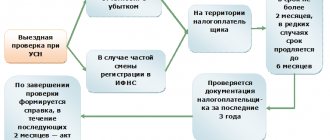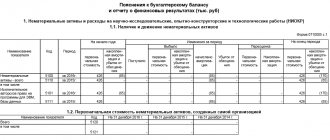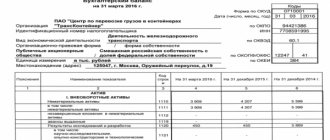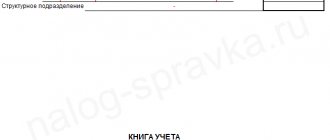Why does a director need to understand financial statements?
The manager is responsible for everything that happens in his company, including accounting. Although the chief accountant or another financial specialist prepares the reports, it is the director who certifies them. The current balance sheet form does not provide for a second signature at all.
Naturally, the manager must understand what he is signing and be able to identify dubious places in the report.
In addition, balance sheets of other organizations often end up on the director’s desk. The fact is that when signing an agreement with a new partner, businessmen usually request detailed information about him, which includes financial statements.
Of course, the counterparties' reports will first be analyzed by the company's financiers. But the last word on concluding a contract in any case remains with the director. He must weigh all the factors, including independently studying the reporting of a potential partner, without relying only on the opinion of his subordinates.
We will consider the analysis methodology using the example of simplified forms of financial statements.
The current form of the balance sheet shows data for three dates: the beginning and end of the reporting year, as well as the beginning of the previous year. Form No. 2 also includes two years of information. Therefore, you can see how the indicators change over time
Balance sheet (form No. 1)
Financial results report (form No. 2)
Who reviews the balance sheet
Persons interested in balance can be divided into these categories:
- Internal users. These are representatives of the company, its employees, managers, and owners. That is, persons included in the company's staff.
- External users. Persons not employed by the company. For example, these could be auditors, investors.
How to fill out a balance sheet ?
Persons viewing the balance sheet are divided into groups depending on their financial interest:
- Direct interest. These are individuals who are directly interested in the results of the organization's activities. These are entities that actually or potentially make a profit from the firm's income. For example, these are investors, banking institutions, creditors and debtors.
- Indirect interest. These are subjects who are interested in the financial affairs of the company not for their own benefit, but to ensure the interests of other persons. For example, this could be tax, law enforcement services, stock exchanges.
- Lack of financial interest. These are people whose interest does not concern the results of activities. For example, these are auditors, analysts, representatives of statistical services, courts, and the media.
All of the above categories of persons are third-party users.
Question: How to disclose information about accounts receivable and accounts payable in notes to the balance sheet View answer
Balance sheet asset
Let's start looking at the balance sheet from the asset. This section reflects the company's resources that it can use to conduct business. Assets are arranged in descending order of liquidity, i.e. the ability to quickly implement them and receive money ( Latin liquidus - “flowing”).
Non-current assets or fixed assets (line 1150) - real estate, equipment, transport, etc.
If your company did not buy or sell fixed assets in the previous two years, then this figure will decrease slightly (on average by several percent per year) due to depreciation. This is the option discussed in the example.
If there were such purchases, then the indicator of non-current assets as of the last reporting date should be higher than for the previous ones.
If you are considering the balance sheet of a third-party company, then the presence of significant fixed assets is one of the indicators that indicates the reliability of a potential partner.
Of course, this does not mean that there is no need to work with counterparties whose indicators on line 1150 are small or zero. For example, many quite successful trading or transport companies actively use rented premises or cars.
Intangible assets (p. 1170) - patents, licenses, etc. They are also subject to depreciation and are reflected in the balance sheet according to the same rules as fixed assets. In our example, they are not present, because we are considering the balance sheet of a small enterprise, for which this type of asset is not very typical.
Inventories (p. 1210) include goods, finished goods, raw materials, and work in progress.
Their growth in dynamics should not exceed the growth rate of revenue, otherwise this indicates that the efficiency of using the company’s resources is decreasing.
To determine the average annual size of inventories, you need to add up the data at the beginning and end of the year and divide the amount by 2. The average annual indicators for other balance sheet items are determined in the same way.
Of course, to more accurately determine average annual figures, it is better to use the values at the beginning of each month. But now we are talking about analysis based on standard balance sheet data, and it does not contain monthly information.
How to check your balance sheet?
A properly compiled balance sheet is an ordered data system that shows the movement of property, the results of the organization’s activities, the state of settlements with counterparties and obligations. The balance sheet is closely related to financial accounting and helps control the operation of the enterprise, as well as preserve the company's property.
The information contained in the balance sheet can be important and interesting not only to the owners of the organization or the Federal Tax Service, to which the company reports with this document. Balance data may be required by other interested parties:
- state statistics bodies;
- to banks in case of a loan application;
- investors and sponsors;
- counterparties;
- administrations of the regions in which the company operates.
Therefore, it is important to correctly draw up a balance sheet and check it: compare the ratios of indicators between different forms. If the balance sheet line is distorted by 10% or more, then according to Art. 15.11 of the Code of Administrative Offenses of the Russian Federation, the tax office can impose a fine of 2000-3000 rubles on a company. If the company's reporting is subject to mandatory audit, then in case of distortions it will be more difficult to obtain a positive audit opinion. Due to errors in the balance sheet, the bank may refuse a loan, and investors may refuse to cooperate. Also, the balance sheet should not contain blots or erasures.
Stages of checking the balance sheet
Checking your balance should start with simple things. Is all key information about the organization included in the document correctly? And this:
- Full name of the organization.
- Organization address.
- Reporting date or period.
- Kind of activity.
- An identification number.
- Organizational and legal form.
Next, check whether the indicators at the beginning of the reporting period and the end of the previous reporting period coincide - in terms of the content of the indicators and the nomenclature of items. One of the important requirements of balance is continuity, when the subsequent balance follows from the previous one.
Reconcile the General Ledger and balance sheet indicators based on data from accounting registers. This will help identify possible deviations and confirm balance sheet items. Also, the balance should be based on inventory data. Conduct an inventory to ensure that the balances that appear on the accounts actually exist.
Another requirement for balance is its unity. This means that the balance sheet should be based on uniform principles of assessment and accounting, when all departments of the company use a single nomenclature of accounting accounts and the same content of accounts. And this should also be monitored not only when checking the balance, but during the very organization of accounting or its maintenance.
It should be remembered that fixed assets must be accounted for at their original cost, which includes the actual costs of construction, delivery, customs duties, installation, setup, specialist consultations, etc. The residual value is obtained by subtracting depreciation from the original cost. Fixed assets are reflected in the balance sheet at their residual value. Intangible assets must be accounted for at their residual value after actual verification.
Keep records of exports and imports in the Kontur.Accounting web service. Simple accounting, payroll and reporting in one service
Interconnection of reporting forms
The main and most indicative criterion for a correctly drawn up balance sheet is the equality of assets and liabilities. But besides this, some indicators of different reporting forms are related to each other. For example, some balance sheet lines and some income statement or cash flow statement lines. And this relationship must be maintained.
Let's compare the indicators of the Balance Sheet and the Income Statement:
- In line 1180 of the balance sheet, subtract the indicators - the result should coincide with report line 2450.
- In line 1420 of the balance sheet, subtract the indicators - the result should coincide with report line 2430.
- In line 1370 of the balance sheet, subtract the indicators - the result should coincide with report line 2400.
Let's compare the indicators of the Balance Sheet and the Statement of Changes in Capital:
- The indicators in line 1310 of the balance sheet must coincide with report lines 3100, 3200, 3300 (authorized capital column).
- The indicators in line 1320 of the balance sheet must coincide with report lines 3100, 3200, 3300 (column Own shares purchased from shareholders).
- The indicators in line 1360 of the balance sheet must coincide with report lines 3100, 3200, 3300 (reserve capital column).
- The indicators in line 1370 of the balance sheet must coincide with report lines 3100, 3200, 3300 (Column Retained Earnings).
- The indicators in line 1300 of the balance sheet must coincide with report lines 3100, 3200, 3300 (Total column).
Let's compare the indicators of the Balance Sheet and Explanations to the Balance Sheet and the Financial Results Report:
- Subtract the indicators of line 5100 in the explanations (column At the end of the period) - the result should coincide with the indicator of line 1110 of the balance sheet (At the end of the reporting period).
- Subtract the indicators of lines 5100 (at the beginning of the year) and 5110 (at the end of the period) in the explanations - the result should coincide with the indicator of line 1110 of the balance sheet (at the end of the last reporting period).
- Subtract the indicators in explanatory line 5110 (At the beginning of the year) - the result should coincide with the indicator in balance sheet line 1110 (At the end of the year preceding the previous reporting period).
- Subtract the indicators in the explanation line 5200 (at the end of the period) - the result should coincide with the balance sheet indicator 1150 (at the end of the reporting period).
- Subtract the indicators in the explanation lines 5200 (at the beginning of the year) and 5210 (at the end of the period) - the result should coincide with the balance line indicator 1150 (at the end of the last reporting period).
- Subtract the indicators in explanatory line 5210 (At the beginning of the year) - the result should coincide with the indicator in balance sheet line 1150 (at the end of the year preceding the previous reporting period).
- Subtract the indicators in the explanatory line 5220 (At the end of the period) - the result should coincide with the indicator in the balance sheet line 1160 (At the end of the reporting period).
- Subtract the indicators in explanatory lines 5220 (At the beginning of the year) and 5230 (At the end of the period) - the results should coincide with the balance sheet line indicator 1160 (at the end of the last reporting period).
- Subtract the indicators in the explanatory line 5230 (At the beginning of the year) - the result should coincide with the indicator in the balance sheet line 1160 (At the end of the year preceding the previous reporting period).
- Subtract the indicators in the explanatory line 5301 (At the end of the period) - the result should coincide with the indicator in the balance sheet line 1170 (At the end of the reporting period).
- Subtract the indicators in explanatory lines 5301 (At the beginning of the year) and 5311 (At the end of the period) - the results should coincide with the balance sheet line indicator 1170 (At the end of the last reporting period).
- Subtract the indicators in explanatory lines 5311 (At the beginning of the year) - the result should coincide with the indicator in balance sheet line 1170 (at the end of the year preceding the previous period).
- Subtract the indicators in the explanation line 5400 (At the end of the period) - the result should coincide with the indicator in the balance sheet line 1210 (At the end of the reporting period).
- Subtract the indicators in the explanation lines 5400 (At the beginning of the year) and 5420 (At the end of the period) - the results should coincide with the balance sheet line indicator 1210 (At the end of the last reporting period).
- Subtract the indicators in the explanation line 5420 (At the beginning of the year) - the result should coincide with the indicator in the balance sheet line 1210 (At the end of the year preceding the previous period).
- Subtract the indicators in the explanation line 5510 (At the end of the period) - the result should coincide with the indicator in the balance sheet line 1230 (At the end of the reporting period).
- Subtract the indicators in explanatory lines 5510 (At the beginning of the year) and 5530 (At the end of the period) - the results should coincide with the indicator in the balance sheet line 1230 (At the end of the last reporting period).
- Subtract the indicators in the explanatory line 5530 (At the beginning of the year) - the result should coincide with the indicator in the balance sheet line 1230 (At the end of the year preceding the previous reporting period).
- The indicator of the explanation line 5560 (Balance at the end of the period) must coincide with the indicator of the balance sheet line 1520 in terms of the amounts of short-term accounts payable (At the end of the reporting period).
- The indicators of explanation lines 5560 (Balance at the beginning of the year) and 5580 (Balance at the end of the period) must correspond to the indicator of balance sheet line 1520 in terms of the amounts of short-term accounts payable as of these dates.
- The indicator of the line of explanations 5580 (Balance at the beginning of the year) must correspond to the indicator of the balance sheet line 1520 in terms of the amounts of short-term accounts payable at the end of the year preceding the previous period.
- The explanation line indicator 5700 (Balance at the end of the period) must correspond to the balance sheet indicator 1540 (At the end of the reporting period).
- The explanation line indicator 5700 (Balance at the beginning of the year) must coincide with the balance line indicator 1540 (At the end of the last period).
Let's compare the Balance Sheet and Cash Flow Statement indicators:
- The report line indicator 4500 (At the end of the current period) must coincide with the balance line indicator 1250 (At the end of the current period).
- The report line indicators 4450 (At the beginning of the current period) and 4500 (At the end of the previous period) should coincide with the balance line indicator 1250 (At the end of the previous period).
- The report line indicator 4450 (At the beginning of the previous period) must coincide with the balance sheet line indicator 1250 (At the end of the year preceding the previous period).
If some indicators in the balance sheet do not agree, you will have to return to checking the reports, and the primary documentation in them. To avoid mistakes and painstaking “manual” accounting, use an accounting program or online service with automated preparation of reports.
Example
Z2018 = (1820 + 1650) / 2 = 1735 thousand rubles.
Z2019 = (1650 + 1800) / 2 = 1725 thousand rubles.
Z2019 / Z2018 = 1725 / 1735 = 99%
V2019 / V2018 = 28000 / 20000 = 140%
Revenue increased significantly, but inventories remained almost at the same level. This suggests that the company has begun to use them much more effectively.
Accounts receivable (p. 1230) are debts to the company. Primarily we are talking about buyers, but there may also be other types of debts, for example:
- suppliers for advances issued;
- budget for overpayment of taxes;
- personnel for accountable amounts.
The best thing is when the “receivables” decrease. If it grows, then the growth rate should be lower than that of revenue.
It is also desirable that accounts receivable do not exceed accounts payable (p. 1520).
Why do you need a balance sheet audit?
The balance sheet is the basic accounting report, and the audit is a set of procedures to provide independent confirmation of its accuracy.
ATTENTION! In the latest edition of the balance sheet, it is necessary to indicate information about the audit organization (auditor).
The auditor mark should only be given to those companies that are subject to mandatory audit. Tax authorities will use it both to impose a fine on the organization itself if it ignored the obligation to undergo an audit, and in order to know from which auditor they can request information on the organization in accordance with Art. 93 Tax Code of the Russian Federation.
Find out what fines are possible for failure to conduct a mandatory audit or failure to submit an audit report from a typical situation from ConsultantPlus. If you do not have access to the K+ system, get a trial online access for free.
Let us remind you! Since 2021, updated accounting reporting forms have been in effect.
Why confirm the accuracy of the balance? There can be many reasons. For example, an audit report is needed to participate in a competition. Or the owner of the company suspected the manager of fraud. It is the opinion of a third-party specialist (auditor) that assets and liabilities are reflected correctly in the balance sheet that can dispel these suspicions.
For information about for whom an audit is mandatory, read the article “Mandatory audit - main criteria.”
Example
DZ2018 = (1300 + 1500) / 2 = 1400 thousand rubles.
DZ2019 = (1500 + 1400) / 2 = 1450 thousand rubles.
KZ2018 = (1900 + 260 + 1820 + 216) / 2 = 2098 thousand rubles.
KZ2019 = (1820 + 216 + 1580 + 40) / 2 = 1828 thousand rubles.
Accounts receivable is growing, but only slightly (1450 / 1400 - 1400 = 4%). This is much lower than the revenue growth rate (40%). In addition, it is significantly lower than accounts payable. This indicates that the company's debt management system is working effectively (provided that accounts payable are repaid without delay).
Cash (p. 1250) is a very fast-moving metric. Many companies almost completely spend all the money they receive, so the figure for this item may be small. But if an organization pays its obligations on time, then the minimum account balance at the end of the period does not indicate problems with the company’s finances.
Liability balance
The liabilities side of the balance sheet lists the sources of funds from which the company finances its assets.
The article “Capital and reserves” (page 1300) for most LLCs consists of two parts:
- Authorized capital is the funds that the founders invested when creating the business. According to the law, for an LLC it must be no less than 10 thousand rubles, and for a public joint-stock company - no less than 100 thousand rubles. The larger the authorized capital, the more reliable the company is in the eyes of counterparties, banks, investors, etc.
- Retained earnings are that part of the company's profits that the founders decided to keep in circulation.
If the authorized capital did not change and the owners of the company did not receive dividends, then the difference between the indicators on line 1300 at the beginning and end of the year will be equal to the financial result. This is exactly the case considered in our example.
Change in capital for 2021 and 2021
K2018 = 2024 – 1640 = 384 thousand rubles.
K2019 = 2480 – 2024 = 456 thousand rubles.
These amounts are equal to the company's net profit on Form No. 2 for 2021 and 2019, respectively.
The item “Long-term borrowed funds” (p. 1410) includes all loans and borrowings received for a period of more than a year.
The article “Short-term borrowed funds” (p. 1510) combines “short-term” loans and borrowings, i.e. received for less than a year.
The mere presence of borrowed funds and an increase in their amount does not mean that the company has problems. However, if loan debts are growing, but revenue remains stagnant or even falls, then this should cause concern. Most likely, in this case, the bank’s money is not invested in development, but is used to “plug holes.”
In our example, revenue increases, but the amount of debt on loans decreases. This indicates the effective use of borrowed funds.
The item “Other long-term liabilities” (page 1450) also lists the company's debts that are due in more than a year. But here we are talking about all other similar debts (except for banks), for example, under long-term contracts with suppliers.
The items “Accounts payable” (p. 1520) and “Other short-term liabilities (p. 1550) include all “non-bank” debts of the organization with a short maturity.
This includes not only debts to counterparties, but also current debts on taxes, wages, accountable amounts, etc.
Short-term accounts payable must be no less than accounts receivable and must not grow at a faster rate than revenue. In our example, the “creditor” even decreases, but the revenue increases.
Analysis of financial ratios
To draw conclusions about the financial position of a company, it is necessary not only to analyze absolute indicators, but also to calculate the relationships between them, i.e. – coefficients. They, like absolute numbers, also need to be studied over time in order to draw conclusions about business development trends. Let's consider the main financial indicators that can be obtained based on financial statements.
- Profitability is the ratio of net profit to revenue or assets. To calculate it, not only the balance sheet is used, but also another main accounting form - the income statement.
Return on sales:
Rp = PE / V
Return on assets:
Ra = PE / A
If a company operates successfully, then not only its revenue and net profit should grow, but also its profitability percentage.
Peculiarities of interconnection of financial reporting indicators
There are a number of key accounting indicators, the values of which must correspond to each other. That is, they are equal. And only in this case can we say that there has been an interconnection of the indicators of the financial reporting forms.
If we reason by analogy with tax reporting, unfortunately, the control ratios of accounting reporting that must be observed are not given in any regulatory document. They were developed by accounting practice.
Please note that the composition of the financial statements has not changed in recent years. It is still approved by order of the Ministry of Finance of Russia dated July 2, 2010 No. 66n. This means that the control ratios to the financial statements for 2021 do not differ from previous reporting periods.
Even if an organization has modified the basic accounting report forms for its needs, the interconnection of the indicators of the accounting reporting forms must still be observed!
Constantly checking the interrelation of indicators in the financial reporting forms will help to quickly find and correct all errors and shortcomings. At the same time, each organization decides for itself how to monitor correlated reporting indicators (lines).
Example
| Period | Revenue | Net profit | Return on sales |
| 2018 | 20000 | 384 | 1,9% |
| 2019 | 28000 | 456 | 1,6% |
| Period | Assets | Net profit | Return on assets |
| 2018 | 4605 | 384 | 8,3% |
| 2019 | 4555 | 456 | 10,0% |
The tables show that, although absolute profit has increased, the percentage of return on sales has decreased slightly. Company management needs to pay attention to the cost structure.
But the return on assets has increased significantly, i.e. The efficiency of using the company's resources as a whole is growing.
- Capital structure. It is characterized by the autonomy coefficient - the ratio of equity capital to assets.
KA = SK / A
In the simplified balance sheet structure, equity is line 1300 “Capital and reserves”. Assets are the result of the balance sheet, i.e. line value 1600.
Sometimes in the economic literature you can find an indication that the normative value of CA should not be lower than 0.5. Those. business owners must finance the company with at least half of their own funds.
However, this approach in many cases resembles measuring the “average temperature in a hospital.” Much depends on the specifics of the business, primarily on the field of activity.
If we are talking about a trading company, then KA may be lower, reaching 0.3. Such companies often rent premises and equipment, and take the goods for sale.
For complex high-tech industries the situation will be the opposite. The owners of such companies usually try to acquire ownership of equipment and production premises. Indeed, in such a situation, any problems with landlords and the need to move can paralyze the business for a long time.
But in any case, the CA should not be overestimated - up to 0.7 - 0.8 or more. This, of course, increases financial stability, but deprives the company of potential income from the use of borrowed funds.
Example
| date | Equity | Assets | CA |
| 31.12.2017 | 1640 | 4600 | 0,36 |
| 31.12.2018 | 2024 | 4610 | 0,44 |
| 31.12.2019 | 2480 | 4500 | 0,55 |
The table shows that CA is growing steadily and reaching the average standard value as of the last reporting date.
- Solvency. The main indicator that characterizes a company's ability to pay off its obligations is the total liquidity ratio. It is equal to the ratio of current assets to short-term liabilities
Klo = OA / KP
Current assets are the sum of inventories, accounts receivable and cash.
OA = page 1210 + page 1230 + page 1250
Short-term liabilities are the sum of all short-term debts of the enterprise.
KP = page 1510 + 1520 + page 1550
The Klo standard can vary from 1 to 2.5. Those. Even in the most extreme case, debts with short maturities should be fully covered by liquid assets.
And here, too, a lot depends on the direction of the company. Trading firms can allow a reduction in KLo to values slightly exceeding 1, because their inventory is usually easy to sell if necessary.
It is usually more difficult for manufacturing enterprises to sell stock balances in warehouses, therefore KLo for them should be higher, approximately in the range of 1.5 - 2.5. But there is no need to increase this coefficient too much either, because while resources are in reserves.
Example
| date | Current assets | Short-term liabilities | Klaw |
| 31.12.2017 | 3480 | 2960 | 1,18 |
| 31.12.2018 | 3550 | 2586 | 1,37 |
| 31.12.2019 | 3500 | 2020 | 1,73 |
CL is steadily increasing and reached 1.73 as of the last reporting date. This indicator allows you to ensure solvency for a company from any field of activity.
Accounting for beginners from postings to balance sheet: reading a balance sheet using an example
How to read a balance sheet using an example? Let's look at this using the data from the report of Prestige LLC.
| Indicator name | Line code | As of 12/31/2020 | As of 12/31/2019 | As of 12/31/2018 |
| I. NON-CURRENT ASSETS | ||||
| Fixed assets | 1150 | 750 | 779 | 810 |
| Financial investments | 1170 | 50 | – | – |
| II. CURRENT ASSETS | ||||
| Reserves | 1210 | 112 | 118 | 116 |
| Accounts receivable | 1230 | 56 | 49 | 51 |
| Cash and cash equivalents | 1250 | – | 10 | 12 |
| BALANCE | 1600 | 968 | 956 | 989 |
| III. CAPITAL AND RESERVES | ||||
| Authorized capital | 1310 | 10 | 10 | 10 |
| Reserve capital | 1360 | 4 | 3 | 2 |
| retained earnings | 1370 | 511 | 478 | 315 |
| V. SHORT-TERM LIABILITIES | ||||
| Accounts payable | 1520 | 443 | 465 | 662 |
| BALANCE | 1700 | 968 | 956 | 989 |
A fleeting glance at the balance sheet - and the first conclusions: the company does not apply PBU 18/02 - SHE and IT are absent from the balance sheet (perhaps the legal entity is related to a small business). The balance sheet currency has not changed sharply over the past 3 years (fluctuation 1–3%), no borrowed funds were attracted, profits grew steadily, which indicates the financial stability of the organization.





